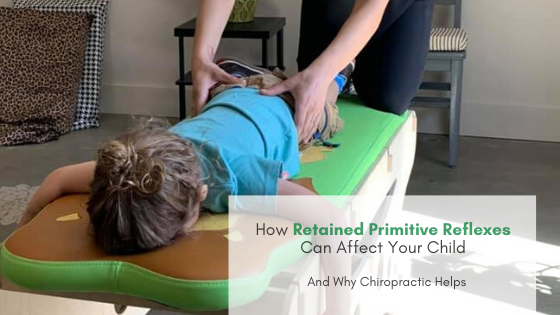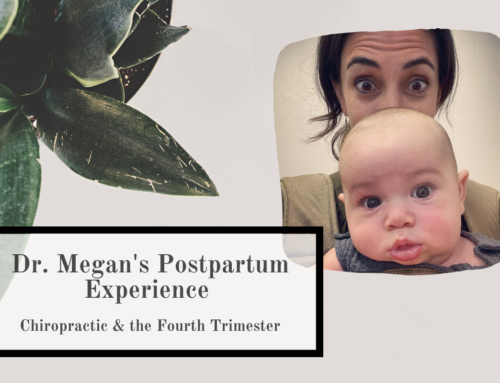Did you know that some of your reflexes are supposed to disappear? Find out the neurological benefits of chiropractic, and how you can set your child up for a healthy, coordinated life by checking for retained primitive motor reflexes.
What are Primitive Reflexes
Primitive reflexes are the natural, automatic movements that full-term babies make in response to stimulus. They’re a key part of the developmental process, preparing a baby for specific functions, like crawling and walking.
These include things you’ve probably seen babies do, without knowing they were so important.
When a baby is startled by a loud noise or sudden movement, we see the Moro Reflex: their arms extending out and their back arching. However, children and adults shouldn’t keep jumping into fight-or-flight mode every time they are surprised; the Moro Reflex should be integrated and disappear by 2-4 months old.
It may seem unimportant that your child’s toes curl out, in or up when the bottom of the foot is touched (the Babinski reflex). But when they begin to walk, you get toe-walking because putting their heel down sends a weird stimulus to the brain.
This throws off their balance and coordination until that reflex is integrated and disappears.
Our motion and motor are definitely primary brain functions, and we can definitely take many actions for granted.
When we get into playing sports or reading and writing, it requires coordination between different parts of the brain. One side understands what the letters are and the other interprets it into language. Then another part tells your hand to write the letter.
So if your brain isn’t balanced and connecting well, reading and writing will be really difficult. Math also requires a lot of neurological coordination!
Our brains are really being exercised doing all these things.
Here’s a great graphic from Brain Balance Center that explains some reflexes and signs that have been retained.
Why Primitive Reflexes Sometimes Stick Around
When these reflexes aren’t integrated, it means the child’s neurology isn’t growing or balancing correctly.
Here’s a few scenarios that could be at the root of retained reflexes. In utero, babies are supposed to be head down for many reasons. One is that the inner ears are designed to balance them upside down for proper neurological development.
Unfortunately, many breech babies are then delivered by cesarean section. That can definitely add further complications.
Breastfeeding is the next step in a baby’s neurological development, as they use their rooting and sucking reflexes, as well as tongue and mouth movement. This is also relevant because in order to nurse, a baby’s head must be fully rotated.
However, bottle-fed babies generally take a bottle without rotating their neck, with considerably less effort.
Engaging with their world in a rotated way is important; it helps create crossing patterns for the two hemispheres of the brain to work together.
All of these factors can put a baby at a disadvantage neurologically.
Then all too frequently, babies live in their seats. From home to daycare, from car seat to swing to stroller. They are never getting to engage their world without some sort of support system around them, and this shuts down the prefrontal cortex of the brain.
How Chiropractic Helps Integrate Reflexes
One Polish study tested 35 preschoolers to determine if they had retained any primitive reflexes; over half had at least residual of these reflexes. When tested for psychomotor skills, one-third of the children had delayed development. The study concluded that testing and reflex integration therapy could prevent, “many difficulties which children can encounter within their social and school life.”
Chiropractic is huge in helping children and adults, to make sure their neurology is growing and developing in balance.
For babies, unsupported tummy time is vital (even if it’s said more frequently). A great way to do this for infants under two months old, is to have the baby lay on the mother’s chest. And do it frequently!
During tummy time, babies need the freedom to move their limbs, lift their head and turn it. They need to engage while in this tummy-time position. It’s not just because it’s great for their muscles–this is a major stimulating factor for the prefrontal cortex of their brains!
A strong prefrontal cortex helps to integrate each primitive reflex at the appropriate time in a baby’s development.
Then as kids develop, the frontal cortex is all about decision-making, relationships, controlling and processing emotions. By prioritizing this neurological development within the first year of life, we can set a child up for massive success.
Local Resources
If you are in the Greenville, SC area, we would love to evaluate your child for primitive reflexes and spinal subluxations. We test for up to 10 age-appropriate primitive reflexes. In addition to our gentle adjustments, we provide parents with handouts and exercises. We want the next generation’s neurology to develop optimally!
Brain Balance Center of Greenville is also a wonderful source for education and support.
You can find many help fun, simple exercise videos on YouTube. Click here for a channel that has very short videos for many reflexes to get you started.
Upstate Specific Chiropractic serves the Greenville, SC area, specializing in pregnancy and pediatric care. To schedule a free consultation, contact us here.
For more videos, information and encouragement towards health, Like our Facebook page.
References
https://blog.brainbalancecenters.com/2014/09/retained-primitive-reflexes-sign-brain-imbalance
https://www.ncbi.nlm.nih.gov/pmc/articles/PMC5778413/
https://www.youtube.com/channel/UCwByu411vmcxI18MrM_CGJQ/videos








Leave a Reply